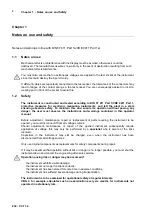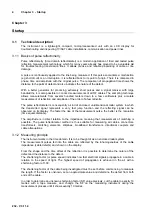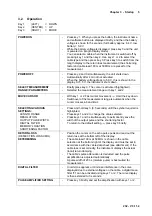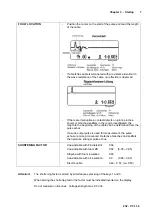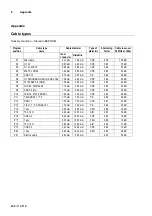
Chapter 3 - Startup
232 - V 3.11.4
5
3.2 Operation
Key 1
(LEFT)
= DOWN
Key 2
(CENTER) = UP
Key 3
(RIGHT)
= MODE
POWER ON
-
Press key 1. When you press the button, the instrument name
and software button are displayed briefly, and then the battery
voltage is shown for 5 seconds. (full battery approx. 6.4 V, low
battery < 5.9 V
-
While the battery voltage is displayed, press key 3 and the unit
is powered on (length display mode) .
-
You can select a cable when the instrument is switched off by
pressing key 1 and then key 2. Use keys 1 or 2 to select the
cable type and then press key 3. Press key 3 to switch from the
length display to the return loss measurement (the shortening
factor and cable loss/100 m at 50 MHz are preset for the
measurement.
POWER OFF
-
Press key 2 and 3 simultaneously, the unit shuts down.
-
Automatically after 4 min of not actuated.
-
When the battery voltage drops to 5.9 V, this is shown in the
display. At 5.5 V, the instrument shuts down.
SELECT MEASUREMENT
RANGE / PARAMETERS
-
Briefly press key 3. The cursor is activated (highlighted).
-
Selected the measurement range with key 1 and 2.
MOVE CURSOR
-
With key 1 or 2. Fast cursor movement
Hold the key down.
-
Switchover of the measurement range is automatic when the
cursor crosses a band limit.
SELECTING VARIOUS
SETTINGS:
LENGTH RANGE
RESOLUTION
OUTPUT PULSE WIDTH
DIGITAL FILTER
MEMORY LOCATION
SHORTENING FACTOR
-
Press and hold key 3 (0.5 seconds) until the symbol required is
highlighted.
-
Press keys 1 and 2 to change the value selected.
-
Press keys 1 and 3 simultaneously to permanently save the
width of the output pulse and the shortening factor.
-
To return to the default setting
, press key 3 briefly.
RETURN LOSS
(REFLECTION LOSS dbRL)
DETERMINING
-
Position the cursor on the echo pulse peak and read out the
return loss at the bottom left of the display.
-
The cable loss/100 m at 50 MHz is shown in the cable
selection at the bottom right of the display and must be set in
accordance with the cable data sheet (see attachment). If the
cable loss is set correctly, the instrument displays the actual
(local) return damping.
-
The cable's pulse attenuation is deducted and the pulse
amplification is adjusted automatically.
-
A pulse width of 20 ns (medium pulse) is best suited for
measurement.
DIGITAL FILTER
-
In order to suppress or minimise interference in the curve
displayed due to external voltages on the cable, a digital mean
filter “Fi” can be activated using keys 1 or 2. The curve display
is then extended to 3 seconds.
PULSE AMPLIFIER SETTING
-
Press key 3 briefly and set the amplification with keys 1 or 2.


